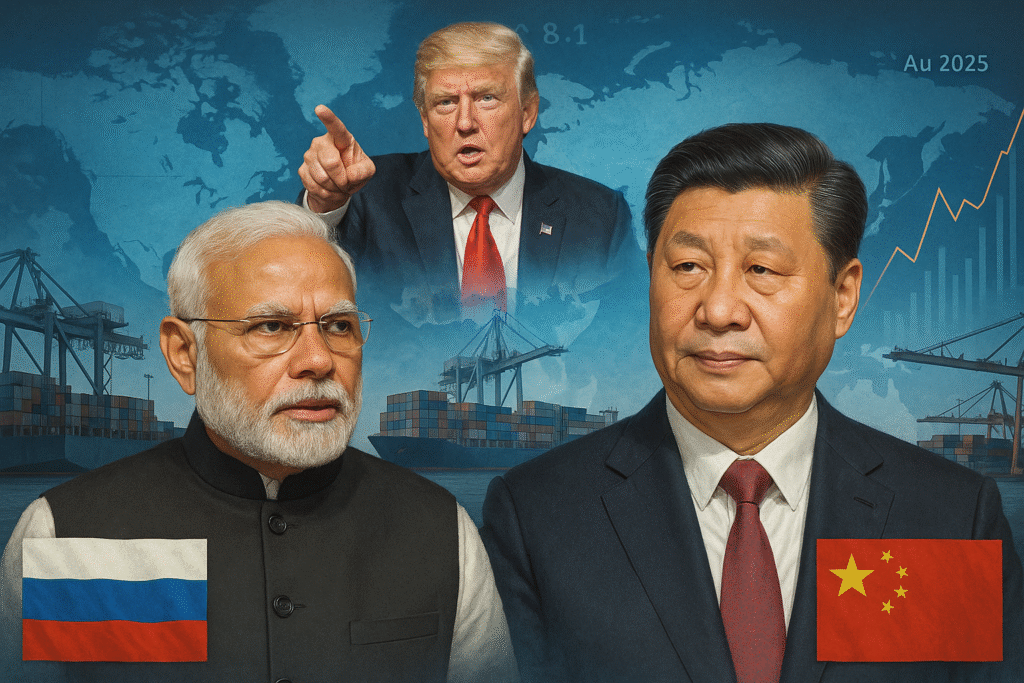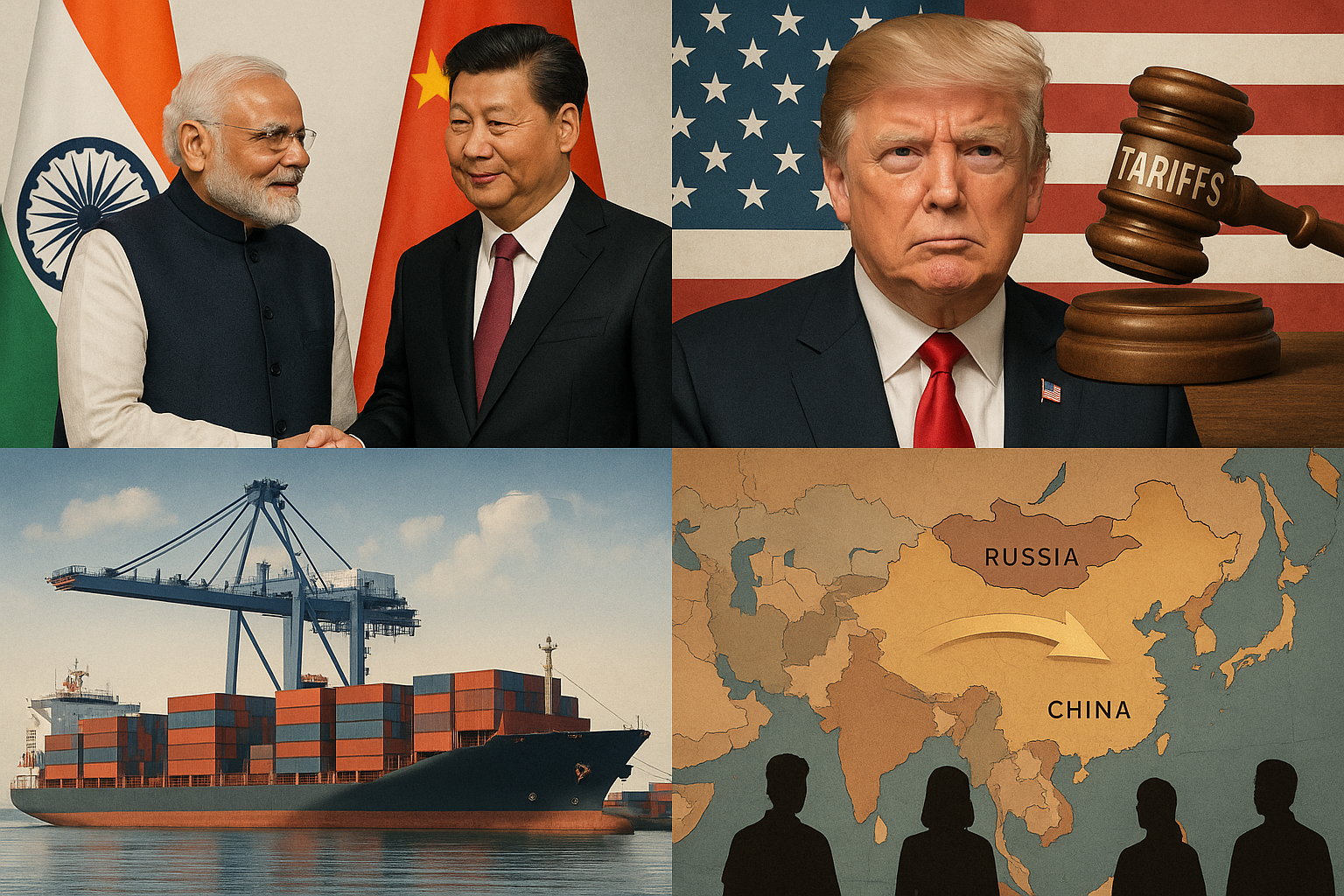Modi–Xi, Trump’s Tariffs and the New Great-Game Are Rewiring Global Trade: Prime Minister Narendra Modi’s first visit to China in seven years, set against new U.S. tariffs on Indian goods and an intensifying China–Russia push to reshape global institutions, isn’t a single story — it’s several tectonic shifts happening at once. This guide explains what happened, why it matters for India’s Make in India ambitions and millions of livelihoods, how Russia and China are trying to build alternative global rules, and what Indian businesses, workers and readers should watch (Updated: August 31, 2025.)
1) What just happened — the fast facts (August 2025)
- Modi met Xi in Tianjin on the sidelines of the Shanghai Cooperation Organisation (SCO) summit — his first trip to China in seven years — and both leaders framed the meeting as a step toward stabilizing ties and restoring some normal economic links. (Reuters, Al Jazeera)
- The U.S. has imposed steep tariffs on many Indian imports (widely reported in late August 2025), a move Washington frames as part of “America First” industrial policy and trade leverage. Those tariffs are already shifting incentives for exporters and investors. (Al Jazeera, Council on Foreign Relations)
- China and Russia are using platforms like the SCO to push coordinated alternatives to Western-led rules and institutions — a deliberate pivot toward multipolar institutional architecture. (Sceeus, Munich Security Conference)
2) Why Modi went to China now — the strategic backdrop
Modi’s trip is not merely diplomatic theater. It comes at a moment when:
- India faces immediate economic pressure from higher U.S. tariffs that threaten key export sectors; and
- Beijing and Moscow are increasingly offering political and economic alternatives to Western-dominated supply chains and finance.
For New Delhi, the calculus is to protect export markets and keep lines of communication open with China while avoiding being boxed into a camp that threatens India’s strategic autonomy. Reuters and other briefings framed the visit as a pragmatic thaw designed to restore travel, trade facilitation and border-management mechanisms. (Reuters, www.ndtv.com)
3) What Trump’s tariffs actually do — immediate economic hits
The headline action — tariffs of 50% or similarly large rates on selected Indian goods — has three immediate economic consequences:
- Export shock for affected sectors: Apparel, footwear, some consumer goods and intermediate inputs are very price-sensitive. High tariffs reduce demand in the United States and quickly cut revenues for exporters. (Al Jazeera, The Guardian)
- Supply-chain reorientation pains: Firms that built capacity to serve U.S. buyers now face either absorbing costs, relocating production, or pivoting to new markets — all costly and slow. (The Budget Lab at Yale)
- Political signaling: Tariffs are not only economic tools — they’re geopolitical pressure. Analysts see them as a lever to change Delhi’s policy choices (for instance, on Russian oil purchases). (Reuters, Council on Foreign Relations)
4) Why Make in India and livelihoods are on the line
Make in India has two intertwined goals: create large-scale manufacturing jobs and plug India into global value chains. Tariffs and geopolitical friction threaten that in three ways:
- Demand shock → job losses. Exporters employ large workforces in manufacturing hubs; a sudden drop in orders risks plant closures or layoffs. Reuters and Guardian reporting emphasize the real potential for sharp declines in exports and employment in affected sectors. (Reuters, The Guardian)
- Investment uncertainty. Multinationals weighing factory placement want predictable trade rules; abrupt tariffs raise the cost of doing business and could slow new investment into India. (Council on Foreign Relations)
- Upstream vulnerability. Many Indian firms rely on imported inputs; retaliatory or defensive measures can raise input costs, squeezing margins and competitiveness. (The Budget Lab at Yale)
Put bluntly: tariffs that make Indian exports less competitive in the U.S. market increase both short-term pain (lost sales, layoffs) and long-term risk (slower factory investment, fewer high-quality jobs).

5) Russia and China’s play: reshaping the rules, not just reacting
China and Russia are moving beyond tactical coordination to institutional strategies:
- The SCO and similar forums are being used to promote infrastructure, energy and financial mechanisms that bypass Western-dominated channels. Analysts and think-tanks argue these forums are prototypes for a different governance architecture. (Sceeus, Munich Security Conference)
- Economic diplomacy as leverage. Moscow and Beijing offer trade, energy and tech deals that can help countries cushion Western pressure — but those offers come with geopolitical strings and different standards for governance and transparency. (Yahoo, Sceeus)
For India this presents a dilemma: closer pragmatic engagement with China (or Russia) can ease immediate economic pain, but may complicate long-term strategic goals and relationships with the West.
6) How Modi can — and likely will — balance competing pressures
New Delhi’s options are constrained but not exhausted. A pragmatic playbook includes:
- Short-term damage control: immediate export assistance (tax relief, working-capital support), rapid retraining funds, and trade-promotion to diversify markets beyond the U.S. and Europe. (Policy responses of this sort are already in discussion among Indian officials and analysts.) (Reuters, Council on Foreign Relations)
- Diplomatic hedging: keep channels open with Beijing (as the Tianjin meeting shows) while sustaining strategic partnerships with the U.S. and other partners. Modi’s Tianjin talks signal precisely that — a long-term view of ties, not a sudden pivot. (Reuters)
- Supply-chain resilience: accelerate domestic sourcing for critical inputs, and negotiate investment protections or relocation incentives to keep factories in India. (The Budget Lab at Yale)
7) What businesses and workers should do — practical steps
- Exporters: immediately map exposure to U.S. tariffs by product and buyer; explore alternative markets and short-term cost-passing strategies.
- Manufacturing employees & unions: press for rapid government support — wage subsidies, retraining programs and local procurement promises to smooth transitions.
- Investors and executives: stress-test supply chains; consider dual-sourcing and near-shore options to reduce single-market dependency.
These are not silver bullets, but they limit downside while policymakers craft longer-term fixes.
8) Big-picture risks & the possible new normal
- Fragmentation of global trade: protracted tariff wars and competing institutional layers (Western-led vs. SCO-led) could raise global trade costs and slow growth. (Munich Security Conference, Sceeus)
- Geopolitical leverage becomes economic pain: countries that rely heavily on any single partner for exports or finance will be vulnerable to political pressure expressed through trade tools. (Reuters)
- Opportunities for alternative partnerships: some countries and firms will find openings to deepen ties with China, Russia or the Global South — but these ties often come with strategic tradeoffs.
9) Bottom line — what readers should take away now
- This is a transitional moment, not a single-event shock: Modi’s trip, Trump’s tariffs, and Russia–China institutional moves are all threads of a broader reordering. (Reuters, Al Jazeera, Sceeus)
- Short-term pain is very real for Indian exporters and workers in exposed sectors — rapid policy responses and business agility will matter most in the coming months. (Reuters)
- Long-term strategy requires balance. India can engage China pragmatically without surrendering strategic autonomy, but the choices will be politically and economically costly if mishandled. (Reuters, Council on Foreign Relations)
Key timeline (Aug 2025)
- Aug 27–28, 2025: U.S. tariff measures on India come into effect; analysts warn of large sectoral impact. (Al Jazeera, The Guardian)
- Aug 29–31, 2025: SCO summit in Tianjin; Modi meets Xi as India signals willingness to normalize aspects of the relationship while navigating tariffs. (Al Jazeera, Reuters)
Short, reader-friendly checklist — what you can do next
- If you work in manufacturing: ask your CFO to run a tariff-impact scenario within 2 weeks.
- If you’re a worker: contact your company HR or union to learn about contingency supports and retraining programs.
- If you follow geopolitics: watch SCO communiqués and trade announcements for practical follow-ups (project finance, new trade corridors, visa/travel rules).
Disclaimer
This article summarizes public reporting and expert analysis available as of August 31, 2025. It is for informational purposes only and does not represent official government positions. Readers should consult primary government and business sources for decisions that affect employment, contracts, or investments. Images used in this article are royalty‑free or licensed for commercial use and are provided here for illustrative purposes.
Sources & further reading (selected)
- Reuters — “China’s Xi meets India’s Modi in Tianjin.” (Reuters)
- Al Jazeera — “Trump’s India tariffs take effect: which sector will be hit.” (Al Jazeera)
- Reuters analysis — “India, US to lose from Trump tariffs as Russia wins.” (Reuters)
- SCEEUS / commentary — “China and Russia are using the Shanghai Cooperation Organization to push alternative global order.” (Sceeus)
- Munich Security Report 2025 — “Multipolarization” (analysis of global order shifts). (Munich Security Conference)
